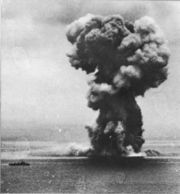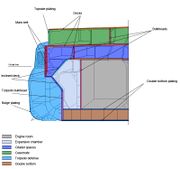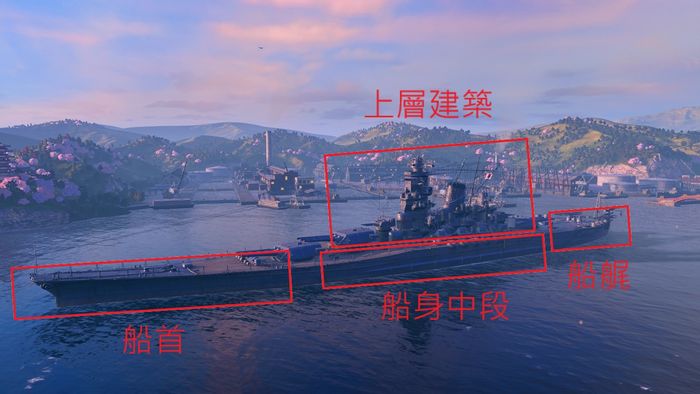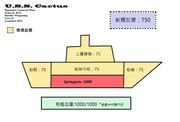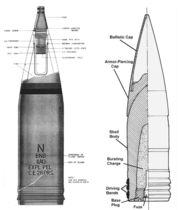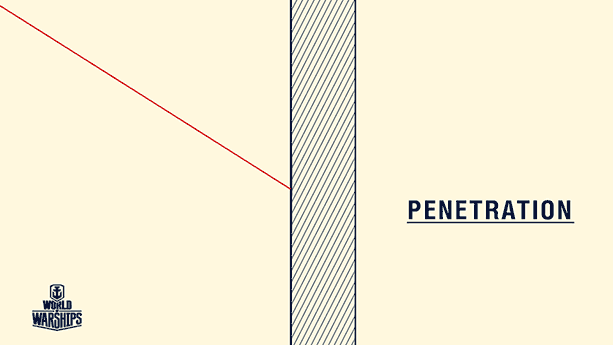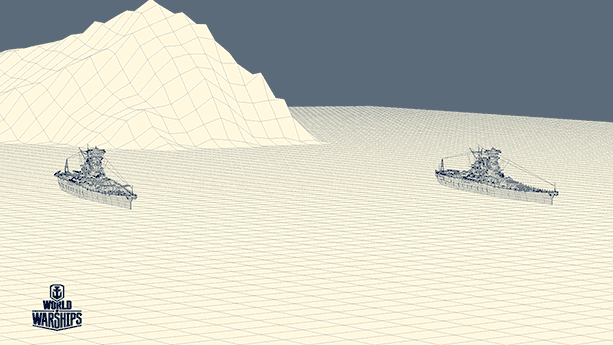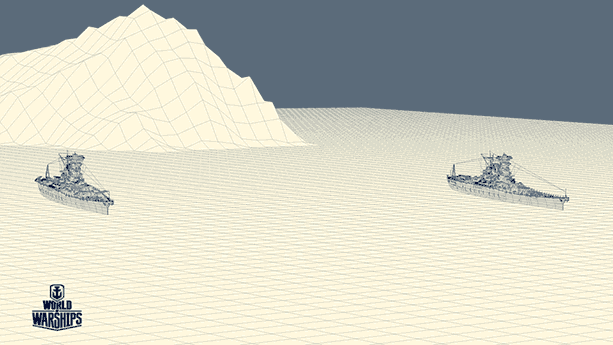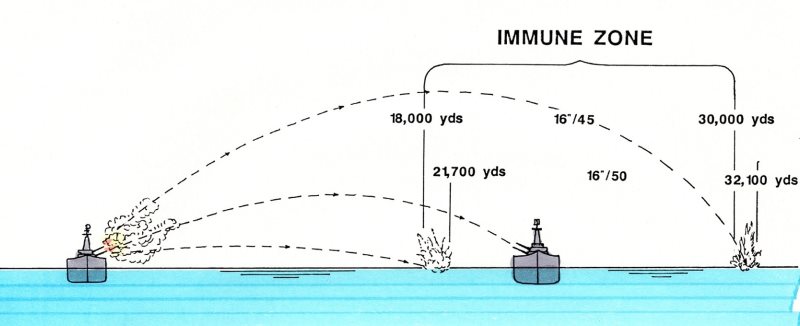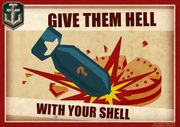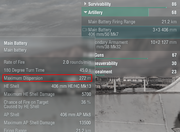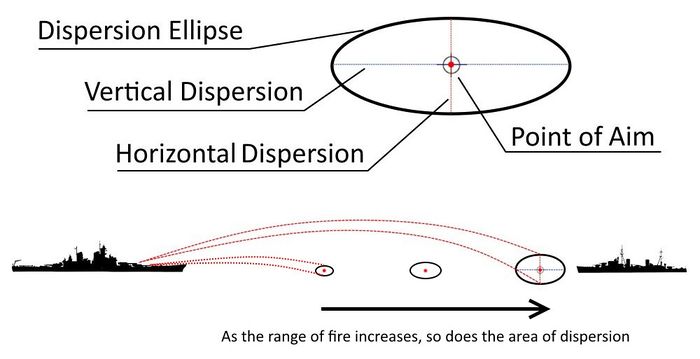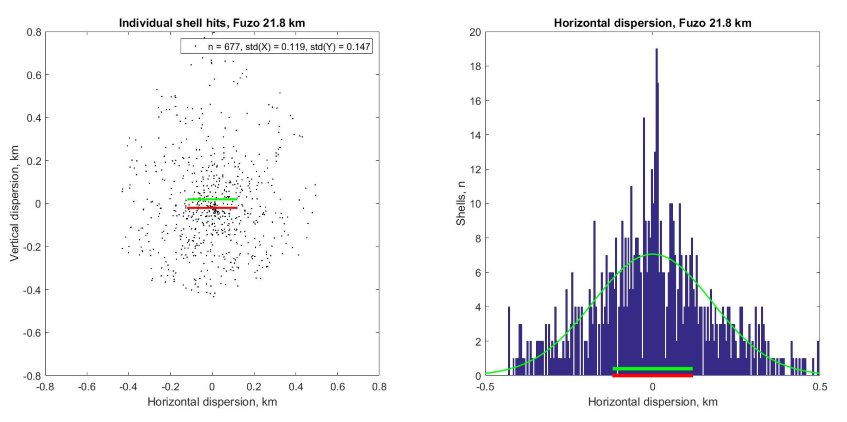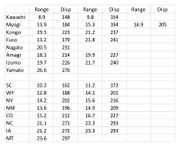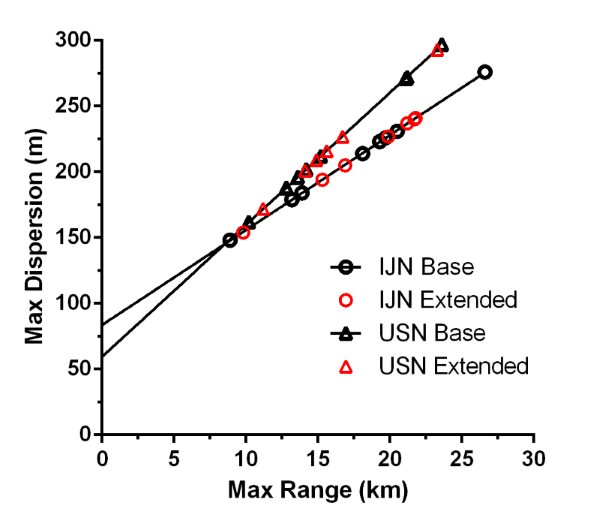炮術與穿甲原理(戰艦世界)
目錄
裝甲與艙間規劃
裝甲
艦艇的裝甲並非一致不變的作為阻擋穿透的障礙(像WOT那樣),而是像多層「蛋糕」般包覆住許多內部建築及機械,因此每個部位是有著不同的裝甲。一發射入船體的砲彈可能會面對四到五層的裝甲帶,且在每一層都可能停下或是被彈開。 就這點上,開發者試圖去保持史實和模擬出每一層較重要的裝甲帶。 但裝甲往往很沉重: 在一艘典型的戰艦上,裝甲通常就占據了艦艇總排水量的 40% 以上。 因此,一些後期的戰艦設計師試圖藉由只在重要艙間如:彈藥庫(magazine)、動力艙間(鍋爐)、火控(control-firing)、指揮(command)以及通訊部門設置厚重裝甲以節省重量。而其他部位如:乾舷,則幾乎沒有裝甲。這種不是全面防護就是沒有保護的方法被稱為「全有全無(all or nothing)」。實務上,這種方案可以承受中口徑及高爆彈對船體無保護部位的打擊,以提高重型穿甲彈的抵抗能力,還允許在裝配重武裝的同時保持高機動性和續航力。
船艦的重要艙間是被裝甲區(citadel)包覆著的,其可以被視為一個頂部封閉,底部開放,斜邊位於船體內的一塊鐵盒。雖然裝甲區越小越好,但這些空間是艦艇作為預備浮力的重要來源,且有助於在其他部分進水時防止沉沒。 在遊戲中,使一艘船的裝甲區血量歸零會直接判定為擊沉,即使其他部位完好如初。
沿著裝甲區的軸線,向上設有船艦的砲座、砲塔以及指揮塔。 船艦的彈藥庫位於砲座內或周圍,儲放著主口徑彈藥,包括發射藥包。 擊穿彈藥庫周圍的裝甲區通常會造成彈藥殉爆(一發入魂)。
那麼當玩家遇見一艘陌生的船艦,要如何得知其重要艙間的位置呢? 無須查閱藍圖,一個受過教育的猜測就足夠了。裝甲區通常位在船身中段,大約艦長的一半。如同經驗法則般,當你可以準確地射擊船側,瞄準船身中間(煙囪下方),接近水線。 當敵方以船艏或船艉朝向你(擺角),射擊其船艏(bow)、船艉(stern)或者上層建築(superstructures),依據情況而定。請注意! 由於彈藥庫裝甲通常就位於主砲塔下方,射擊船艏往往會被彈開。
艦艇除了有用來防禦直射火力(水平攻擊)的垂直裝甲帶(belt),還有用來防禦曲射火力(垂直攻擊)的甲板裝甲(deck armor)--砲彈在攻擊遠距離目標時往往是從頂部射入。然而,因為有著大區域要保護,甲板裝甲要比垂直裝甲帶來的薄。這就是為何當砲彈不能有效擊穿一艘船艦的垂直裝甲帶時,攻擊其甲板卻可以的原因了。
船艦的部位血條規劃
由於船艦是被設計來進行長時間的獨立行動,她們就像是一個軍事基地和戰鬥車輛。因此,船艦內部有很大一部分是無關戰鬥,但對每日生活是至關重要的。 一發在砲戰中摧毀洗衣間或是畫廊的砲彈相比命中彈藥庫或者引擎部的來說,影響微乎其微。
這就是為何不像戰車世界中的戰車,戰艦世界中的船艦是被分為多個區塊,且每一個有著不同的血量。遊戲中,船艦被分為艦艏、艦艉、船身中段(不含裝甲區)、裝甲區以及上層建築。以下是詳細的砲彈傷害計算機制。
Each section (except the citadel) has two thresholds, where after each one is reached the damage it receives is reduced. The threshold levels for each section of each ship varies.
- In the initial state, the ship will receive damage normally (x0.33 for shell penetration). The section starts off clean and gets darker as it takes more damage.
- After the first threshold is reached, the damage received is halved (x0.165 dmg for shell penetration). At this stage, the section of the ship is visually blackened.
- Finally, once the second threshold is reached the section stops receiving damage, an effect known as damage saturation. There is no visual difference to the first threshold, you'll only notice that your shells stop doing damage to the section.
- Regardless of the state of the section, over-penetration will always deal x0.1 dmg and citadel hits will always deal x1.0 damage, even after the section's HP pool is completely depleted.
- If the midsection's second threshold has been reached, all other sections will take damage as if it had passed the first threshold even if it hasn't taken any damage yet. Damage from fire, flooding, over-penetration and citadel hits will not reduce any section's HP pool (but they will still reduce the ship's total HP as normal). A section with no HP left may still burn or flood normally and continue dealing damage to the ship.
每艘船擁有:船體血量、部位血量(艦艏、艦艉等)和裝甲區,部位血量小於船體血量。而上述三塊血量總和大於面板血量,這是為避免船殘血卻打不沉的情況
一般貫穿傷害是 砲彈傷害/6
- 當攻擊一艘完好如初的船的船首時,是砲彈傷害/6*2,並同時扣除船體與部位血量
- 隨著其中之一的血量歸零,傷害變為砲彈傷害/6
- 而兩者皆歸零,攻擊此部位的砲彈便無法再造成傷害,僅剩起火或進水可再造成傷害(除非對方使用維修小組)
今以一種 900 傷的 AP 彈攻擊右方船艦的船艏,砲彈不會過穿,不會彈開與碎裂
在其船首血量還未打空時,傷害為 900/6*2=300 ,同時每中一發砲彈,船體與部位血量各減 900/6=150
在命中 5 發後,船艏血量歸零,傷害變為 900/6=150 船體血量持續減 900/6=150
再繼續射擊 45 發砲彈後,船體血量歸零,攻擊此部位的砲彈便無法再造成傷害,僅剩起火或進水可再造成傷害(除非對方使用維修小組)
註1:所以平均分散各部位傷害,並不能避免減傷效果
註2:裝甲區血量必大於該船血量,是為避免打出黑牌卻零傷
註3:由於船上有許多配件如:防空炮,所以有時出現擊穿勳帶卻零傷是因為配件血量吸收了傷害
艦艇部件
在遊戲中,艦艇有許多的配件:引擎 (推進裝置)、舵、防空裝備、魚雷發射管、砲塔......等。這些配件有三種狀態:無受損、故障、被摧毀。
* 引擎 (推進裝置)、舵不會被摧毀,只會受損
* 防空裝備、副砲沒有受損狀態,只有壞與沒壞
一個受損的配件會失去功能直到它被修復,一個被破壞的配件是無法被修復的。
每個配件有著固定的血量。每次受到傷害時,遊戲便會計算他變為受損的機率(這機率可被技能預防性養護降低約 30% )。 對低血量的配件而言,受到重創的機率是提升的 (因受損機率算法猜測為受到傷害/配件血量)。當配件血量歸0,其便判定為被擊毀。
彈種
戰艦世界目前有兩個彈種:
- 高爆彈 (HE)
- 穿甲彈 (AP)
AP 與 HE 的彈道模型是相同的; 但是,有些船艦他們的 AP 與 HE 的炮口初速是不同的。 為了更好的觀看射擊過程,遊戲內的跟隨砲彈視角(預設 Z 鍵)可能不會與現實吻合。
高爆彈 (HE)
這種砲彈有著觸碰引信,撞擊到目標便會爆炸。 如同 AP 彈,他們在碎彈時是 0 傷,普通擊穿時造成 1/3 傷害,而擊穿裝甲區時造成 100% 傷害。除了以上的直接傷害,HE 彈也可以輕易地擊傷艦艇配件,特別是防空炮組,並有機率造成火災,進而造成大量傷害(疊 DOT)。
HE 彈的穿透機制
與 AP 彈不同的是,HE 彈的穿透不是基於入射角或是砲彈速度,而是每顆砲彈有著固定的穿深值用來與船艦的裝甲比較。多數船艦的砲彈穿深約是口徑/6,但是在英國戰艦、德國戰艦及德國巡洋艦上則是口徑/4。這個穿深值可以用IFHE 高爆彈的慣信引信(指揮官技能) 提高30%。加成後的結果會被四捨五入到mm單位。如果裝甲厚度大於等於穿深值,則判定為碎彈;如果裝甲遠薄於穿深,則視為穿透。
以下是總結:
| Ships | 沒有 IFHE | 有 IFHE |
|---|---|---|
| 一般船艦 | 約口徑 / 6) | 約口徑 * 1.3 / 6) |
| 英國戰艦 德國巡洋艦 德國戰艦 |
約口徑 / 4 ) |
約口徑 * 1.3 / 4) |
舉例: Cleveland 口徑為 152mm。152/6 是 25.33 四捨五入為 25 。因此當裝甲大於等於25時會碎彈。 Thus, any armor plate of 25 mm or greater will shatter her shells, while armor of 24 mm or lower will be penetrated. With IFHE, the HE penetration increases to 32.93, which is rounded to 33 mm. Thus, with IFHE it would take at least a 33 mm plate to shatter her shells, while armor of 32 mm or lower would be penetrated.
| Ships | Without IFHE | With IFHE |
|---|---|---|
| Default | (armor + 0.5) * 6 | (armor + 0.5) * 6 / 1.3 |
| British battleships German cruisers German battleships |
(armor + 0.5) * 4 |
(armor + 0.5) * 4 / 1.3 |
Example: Shchors has 75 mm of citadel armor. Therefore it would take at least (75 + 0.5) * 6 = 453 mm shell diameter to citadel her with HE. With IFHE this decreases to (75 + 0.5) * 6 / 1.3 = 348.46 mm, or 349 mm since all shell diameters are integers. British battleships, German cruisers, and German battleships without IFHE can citadel Shchors with 302 mm shells or greater. With the addition of IFHE, such ships can citadel her with shells of at least 233 mm diameter.
穿甲彈(AP)
有別於 HE 彈,AP 彈只在穿透裝甲時造成傷害。 AP 彈的引信會在通過裝甲時啟動,而在史實上,引信時間會設置在讓砲彈在穿透裝甲後,再前進 10 公尺左右引爆。這樣會使砲彈剛好在戰艦內部引爆。另一方面,當以 AP 彈攻擊小型或輕裝甲目標如:驅逐艦,海防艦等,就會有可能「過度擊穿」—————在穿出整艘船體後才爆炸,或者因裝甲不夠厚而未啟動引信。讓我們用 Iowa 的 AP 彈 Mark 8 16吋來示範這個機制。 這種砲彈的的 Mark 21 基礎起爆引信(BDF) 有著 0.033 秒的延遲。而要使引信啟動需要:在 0 度入射角時至少 1.5 吋(3.8 公分)的裝甲。或在 65 度時至少 0.375 吋 (1 公分)的裝甲。這門砲在全新時且用全藥包發射時的炮口初速為 762 公尺/秒。 因此,如果砲彈在離開砲膛後立刻撞上一個 1.5 吋的裝甲板,那它會在前進 762*0.033 = 25 公尺後爆炸。大部分在遊戲中的 AP 彈的引信設置在 0.033 秒,但有些是特別的 0.1 秒。在版本 0.3.1,不同口徑的 AP 彈引信所需的裝甲厚度如下所列 (口徑 - 裝甲): 410mm - 68mm, 356mm - 59mm, 203mm - 34mm, 155mm - 26mm.
未擊穿 (跳彈/未穿透) 是無法造成傷害的,無論你是用 AP 彈還是 HE 彈(HE 彈不會跳彈)。然而,HE 彈只要擊中便有機會起火或因其濺射傷害而破壞配件。
AP 彈的入射角決定它是否會被彈開(美國的 203 mm炮較特別):
- 0-30 度 -> 強制跳彈 (0-22.5 美國 203 mm炮)
- 30-45 度 -> 有機率彈開 (22.5-30 美國的 203 mm炮)
- 45-90 度 -> 必不會被彈開 (30-90 美國的 203 mm炮)
Penetrations deal x0.33 of the shell's listed damage. Whether AP or HE, it must penetrate the armor and detonate inside the ship. Over-penetrations deal x0.10 of the shell's listed damage. Over-penetration is when a shell penetrates the ship through-and-through, before it has a chance to detonate inside the ship. Theoretically HE will never over-penetrate due to its low detonator threshold and shorter fuze. Citadel hits will always deal x1.0 of the shell's listed damage (though citadel over-penetration is still possible, and will only deal x0.10 damage). It is impossible to get a citadel hit on a destroyer, as they no longer have them per se (it was removed in 0.2.4/0.3.0). Prior to 0.4.1, penetrations on a destroyer's midsection will deal x0.5 of the shell's listed damage (in lieu of the absence of citadels), however this is no longer the case and penetrations to it will deal the standard x0.33 of the shell's listed damage.
Properly angling the ship matters a great deal when the enemy is shooting AP shells: when an AP shell encounters armor at an angle, it has to pass a greater amount of armor for penetration. Additionally, at certain critical angle (below ~20-40°), the shell will simply ricochet, even if it might have ad enough armor penetration. A shell may still cause damage after the ricochet, but only to the same ship. If the armor thickness is less than 1/14.3 of shell's caliber, a ricochet does not occur regardless of armor encounter angle.
There are certain engagement ranges when AP shells will encounter both the belt and the deck armor at fairly large angles, and will have a high probability of either non-penetration or ricochets. The distance at which both plunging fire and direct enemy fire is less effective is called the immunity zone (IZ). Despite the absolutist nature of its name, the immunity zone concept does not imply any sort of invulnerability. A ship fighting within its IZ will still probably suffer when hit, but it is theoretically proof against singularly catastrophic hits to the citadel. (plunging-fire still need more testing, the issue with the capped ranges causing the shells were benefit from it being "auto-bounce" against deck armor)
AP shells can penetrate ship's armor even below the waterline, after traveling through water. The illustration to the right depicts a typical underwater trajectory of an AP shell: (1) - shell enters the water and is fuzed due to rapid deceleration (2) - trajectory angle changed (this happens every time an AP shell hits water) (3) - after a short delay, the fuze explodes the shell. The image also demonstrates two outcomes of an underwater hit: armor penetration, and a ricochet. As of 0.4.1 the underwater hits do not cause flooding.
副砲
大致上,副砲是發射 HE 彈的。當然也是有發射 AP 彈的,例如:Giulio Cesare 的 120mm/50、中階日本戰艦的 140mm/50、低階德國戰艦的 150mm/45、 Ishizuchi 的 152mm/50、Nelson 的 152mm/50、Izumo 和 Yamato 的155mm/60、Kaga 的 200mm/50 等。詳細的資料可於港口右方的規格表查閱。
在遊戲中,副砲是由系統自動進行攻擊的(可以P鍵開關),其瞄準點位於船身中段水線。在長距離攻擊時,砲彈會因為散佈而打到其他部位。然而,在近距離內,砲彈會集中在船艦的主裝甲帶。因此除非對方裝甲不厚或副砲本身使用 AP 彈,否則副炮的傷害多半來自於間接火傷。
自0.7.11版起,所有副砲只發射 HE 彈。
彈種的使用時機
以下是三個艦級彈種使用的原則
戰列艦
Shooting other battleships with AP is most effective with direct fire at point-blank and medium ranges, roughly up to ~10-12 kilometers. The enemy battleship shouldn't be at too great of an angle; ideally, it should be perpendicular to your line of fire. You might also get some citadel hits with plunging fire at maximum fire ranges. If you aren't positive that you have a good chance of penetrating the citadel, HE shells are a better choice.
AP shells should be used against well-armored cruisers and carriers as well, when you are certain that a volley at the waterline will penetrate the citadel. Since their armor thickness will be nowhere near that of a battleship, angling will affect your AP shells to a lesser degree. It might be a good idea to light a carrier on fire first, though, to prevent it from launching aircraft
Against lightly-armored cruisers and carriers, you should be using HE shells -- they have enough armor penetration to damage citadels. However, some carriers have enough armor to resist HE, and AP should be shot at them. It must also be noted that an AP shell can deal much more damage against a citadel. You should also use HE against destroyers -- AP shells will almost always over-penetrate; and HE shells will knock out multiple modules on a DD, making it easy prey after a few hits.
One last thing: it's better to use the shell of the wrong type (e.g. AP against a destroyer that suddenly materialized near your ship) than to start a long half-minute reload. Sub-optimal damage is better than no damage at all.
巡洋艦
Against battleships your best bet is HE shells. Consistent HE hits and nonstop fires are a bane of many battleship drivers' existence. However, don't try to fight a battleship single-handedly; a skilled BB driver can dispatch you in a few well-aimed AP salvos. At point-blank ranges and favorable angles you can also try to penetrate the battleship's citadel with AP shells, though it's generally not a good idea to be that close to a battleship in the first place.
Against other cruisers and carriers use AP shells at close and medium ranges, when you can reliably hit the citadel: a well-aimed salvo remove as much as half of the other cruiser's HP. If the cruiser is far away, or is angling too much, use HE; HE should also be used against the destroyers in practically all situations.
驅逐艦
When driving most destroyers, your main weapons should be your torpedoes (especially so if you're driving an IJN DD). However, HE shells can still be very useful when fighting other destroyers, or providing additional fire against enemy capital ships -- in the latter case, your shells won't be doing much damage, but you can make up for that with the sheer number of shells, and fires.
AP shells can sometimes be used against lightly armored enemy cruisers and carriers, since you have just enough armor penetration to defeat their citadel armor, and can also sometimes be used against other Destroyers because of their higher damage (although they will not destroy modules like HE shells do).
彈著散布
However perfectly a naval gun on a stationary ship may be laying, successive rounds will not impact on a single point but will fall in a pattern scattered both in deflection and in range. This phenomenon is called dispersion and, irrespective of human and constant error, it is caused by multiple inherent factors: minor variations in the weight of the projectile, differences in the rate of ignition of the propellant, variations in the temperature of the bore from round to round, physical limitations of precision in setting values of deflection and quadrant elevation on the respective scales, minor variations in wind, air density or air pressure, and so on.
Observing the position of the surface bursts around our point of aim, we find that they fall into a roughly elliptical area in relation to the line of fire. An ellipse constructed around the dispersion area is called the dispersion ellipse. Every time a player orders his main caliber guns to fire, the game engine constructs a 2-D ellipse around the point of aim, and does so independently for each salvo fired. A double-click will fire all guns in one salvo with one dispersion ellipse, sequential fire will construct dispersion ellipse for each turret salvo separately. This ellipse has a certain length and width values, which are dependent on the characteristics of the gun. The dispersion value displayed in port is the horizontal length of the dispersion ellipse at the maximum fire range, i.e. a value that describes the lateral distribution of the shells relative to the player's ship.
Shell impacts within the dispersion ellipse are not uniformly distributed over the surface, but lie more thickly towards the center of aim. The intensity with which the shells fall in different points of the area of dispersion, can be described by a Gaussian (normal) distribution. The in-port value describes dispersion in terms of one probable error, i.e. it gives a value where 50% of the fired shells will land around the point of aim. This has been confirmed by experiments conducted by the players. Port dispersion value (red bar in the graph below) is the standard deviation (green bar) of shell hits across the horizontal axis of the dispersion ellipse:
If the shooting distance is below the maximum range, the horizontal dispersion value decreases accordingly. Horizontal dispersion values at distances other than maximum firing range, as well as the vertical dispersion values have not been made public by WarGaming. However, based on the user collected data for some ship they are as follows:
data will be added later
Dispersion values are same for HE and AP shells of the same gun. The player's gun dispersion value can be modified by player's equipment and by enemy's camouflage. Gun Fire Control System Modification 2 decreases the area of the shell dispersion ellipse by 7%. Additionally, WarGaming has indicated that not acquiring the target with the X button increases dispersion by an unspecified amount.
If all base and maximum dispersion values for battleships are plotted, two distinct linear trends emerge: one for IJN, and another for the USN tree:
Curiously, one could hypothesize that battleship dispersion at ranges below maximum also follows this linear pattern. For example, even though WG does not disclose Iowa's dispersion at 10 kilometers, by looking at this graph we can estimate it to be around 150 meters, etc. If that is correct, then all IJN battleships have superior accuracy to their USN brethren at ranges above ~10 kilometers, and vice versa.
For patch 0.4.1, WG has decreased the close-range (i.e. below 4km) dispersion values for all ships.
